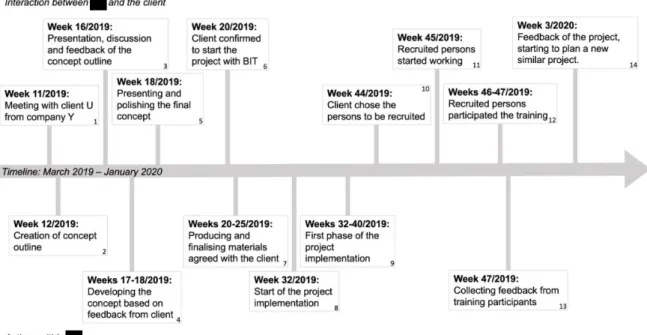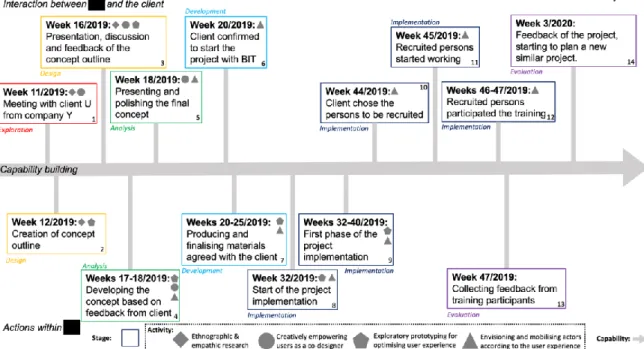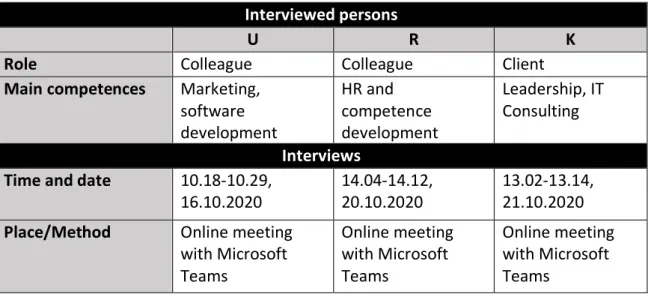The purpose of this study is to create a framework for the co-creation of new values and services that can be used by employees and customers of Company X (Company X). The focus of this study is to develop for Company X a framework for value co-creation and new services that helps its employees and customers develop new services.
Needs and objectives
Research problems and questions
Which service design methods and processes should be used in a framework developed for Company X's needs. The third subchapter provides a complementary alternative to the service design framework by introducing the multidimensional new service development model for value co-creation.
Key concepts
- Service
- Value
- Service Design
- Co-creation
It is about the customer co-constructing a service experience that fits their context with the help of service planning methods. Service Design encourages service designers to adopt a truly empathetic and human-centered approach due to the high importance of co-creation in services.
Framework for Service Design
- Exploration
- Creation
- Reflection
- Implementation
In the research phase, the first task is to understand the culture and goals of the service company. Another key factor for a successful implementation phase is understanding the importance of employees as key players in the service from this point forward.
Multidimensional New Service Development Model for Value Cocreation
The activity dimension involves using ethnographic and empathic design research to access contextual and holistic user experiences and build value propositions based on that that fit users' perceived use value. The activity dimension also includes prototyping, which can iteratively explore and test how to best configure provider resources, processes, and outcomes to support use-value.

Methods for Service Design
- Five whys
- Personas
- Scenario-based design
- Storytelling
- Idea generation
- Agile Development
- Co-creation
- Business model canvas
It can be used to collaboratively study and innovate service experiences by involving, for example, staff members, designers, executives or customers. The Business Model Canvas is a tool that can be used during the service implementation phase to clarify the fit between the business strategy and the designed service.
Target of the research
This chapter presents the objective of the research, the objective, the research problems and the development task. This chapter also describes the methodology and methods, as well as the data and types of analysis used for the analysis. Finally, the implementation part and the presentation of the results lay the foundation for the resulting framework.
Objective, problems, development task
Methodology and methods
Ontology and epistemology
Within this epistemology, individuals' sense of identity derives from interaction and communication with others. These actions lead to the individual's response to others and the adaptation of his understanding and behavior, as a collective sense of order where reality is the result of "negotiations" with others.
Research approach and strategy
Within case study strategies, four different strategies exist namely single case versus multiple case, and holistic case versus embedded case. Alternatively, individual cases may also represent typical cases, or cases that have not been extensively studied before. Usually, the single case strategy is applied when students conduct the research for the organization they work for.
For example, holistic cases are involved when an organization is studied as a whole, instead of examining its logical sub-units, such as departments or teams, separately.
Methods and time horizon
Data and types of analysis used
Semi-structured interviews can be used to collect narrative data and the main priority is to find points that symbolize for example organizational politics, culture and change. Semi-structured interviews are often used in qualitative research as the data gathered from them can be used to discover and understand not only what and how, but also why something happened. Secondary data can be quantitative or qualitative and is often used as part of a case study.
Secondary documentary data can be analyzed quantitatively and qualitatively, and they can be used as a means of triangulating primary data collected for example through interviews.
Implementation
The case
Interviews
After final considerations, the client confirmed in week 20 that they would start the project based on the concept we had developed together. In addition, I interviewed one of the client's representatives, K, who was most involved in the case project from the client's side. U pointed out that the concept partly stemmed from the collaboration that had previously existed with the client in other forms.
R saw that company X succeeded in creating value for the customer and his company with the service concept that we developed together with them.

Secondary data
K mentioned that at the final phase of the implementation there were few things that had to be done differently from K's point of view. The narrative summaries of the interviews of colleagues U and R, in chapter 3.5.2, show that they shared similar views about the value that Company X created for the customer and about their role in it as individuals. The narrative summary of the interview with client K, in chapter 3.5.2, shows that from his point of view, Company X did create value and that they, as a client, also co-created the value with Company X.
The conclusion of the three interviews is that the stakeholders who participated in the case project shared the same views on the value it created for the client.
Results
Case compared to Service design framework
Since both are used in the field, I decided to compare the case project with both sets of principles. Interdisciplinarity: Interdisciplinarity, as described in chapter 2.1.3, was strongly present in the case project, as can be seen from the composition of the team that participated in the project. In the case project, this took the form of presentations, including visual timelines of the project and prototypes of the website and advertisements that Company X was able to design and create during the project.
Client K described in the interview how they were closely involved in the implementation phase and he saw this as a vital part of the success of the case project.

Case compared to New Service Development Model for Value Co-Creation
The two steps of the case project corresponding to the NSD model analysis phase are demonstrated in Figure 6. In the case project there were two steps corresponding to the NSD model development phase, which can be seen in Figure 6. Colleague R brought similar experiences in her interview, saying that participation in the case project improved.
In conclusion, the analysis of the case project shows that it fit the NSD model very well.

Summary
The purpose of this study was to equip Company X to better serve its customers and compete against its competitors by creating a service design framework for co-creating value and new services. Subchapter 4.1 provides answers to the research questions by presenting the results, how they were obtained and based on the results. As part of this, the framework for co-creation of value and new services is presented and how it could be implemented for Company X is considered.
Consideration of results
Framework for co-creating value and new services for Company X
The framework consists of 11 separate steps, each belonging to one of the six phases. For each of the 11 steps of the framework, I have identified service design methods that would be appropriate for that particular step and phase, as shown in Appendix 2. The purpose of this is to provide clarity and guide the user of the framework through taking appropriate actions in the right context.
The framework developed, presented in appendix 3, being a synthesis of the theoretical framework of chapter 2 and the results of the research results summarized in chapter 3.7, provides the answer to the main research question, that is, how can employees and customers collaborate. create new value and services with a service design framework.
Recommendation for how to implement the framework
Feedback from the commissioning organisation
Supervisor L also mentioned that he thinks that using this framework will clearly differentiate Company X from its competitors and as such is highly valuable to Company X's business. A concrete proof of this is the fact that as a result of the case a completely new service category was created for Company X, which its competitors do not currently offer. He found it extremely valuable that the framework I developed adopted methods already widely and long used in software development.
He looks forward to starting to use the framework with Company X's customers and to see how it can improve Company X's services and, as a result, increase customer satisfaction.
Validity
He particularly highlighted the importance of the initial stages of the framework, which focus on finding out the real needs and problems to be solved. The secondary data that was used can be considered to have a high validity, since the primary use of data is to act as one of the main performance indicators of Company X. Therefore, the importance of the reliability, accuracy and consistency of the this one. data is high for company X.
The aim of this study was not to find generalizable results and as such the results are not generalizable, but only valid in the context of Company X.
Reliability
Much attention has been paid to transparently describing the methods by which the data were examined and how conclusions were drawn from the data. Since the interviews were conducted with audio only via Microsoft Teams, the possibility of interview bias caused by non-verbal behavior does not exist. The secondary data used in this study can be considered reliable as the nature of the data is such that there can be no measurement bias.
If measurement bias would have affected the data, this would have been noticed as the data is crucial to measuring Company X's financial performance.
Ethics
I paid attention to avoid interviewer bias by asking each interview question with a similar tone and in a similar manner as neutrally as possible. The research has been carefully designed and documented in this report and as a conclusion similar results with similar consistency should be produced in another occasion or by another researcher.
Development ideas and suggestions for further research
Such study should also bring forward ideas on how to further develop the original framework to better suit Company X and its customers' needs. Another suggestion for further research would be to study what would be the most appropriate way to implement such a framework. Such a study should at least pay attention to change management practices and ways in which people learn new methods in an organizational setting.
Own learning and self-reflection
As the situation with the virus eased a bit and as I began to get used to living and working in new conditions, I felt that I could continue working on my thesis. All this paid off, as I was able to write my thesis in a more compact schedule and I am satisfied with the final result. Finally, it is time to acknowledge and thank the people who supported me and participated in the case project.
I would like to thank my colleagues involved in the case project, my managers for supporting me along the way, the client and their team, my thesis advisor, friends and family who have fully supported me throughout this long process.

